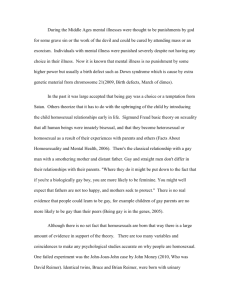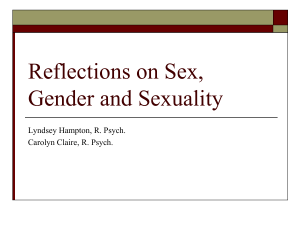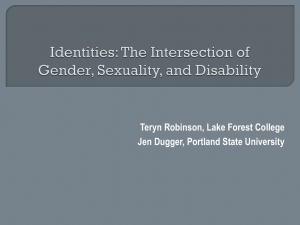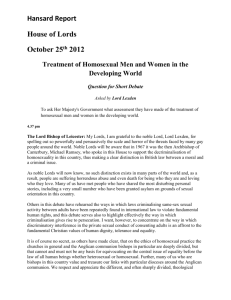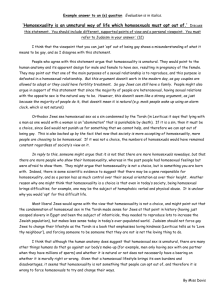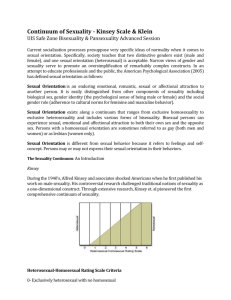A NEW GENDER PERSPECTIVE FOR BASIC INCOME
advertisement
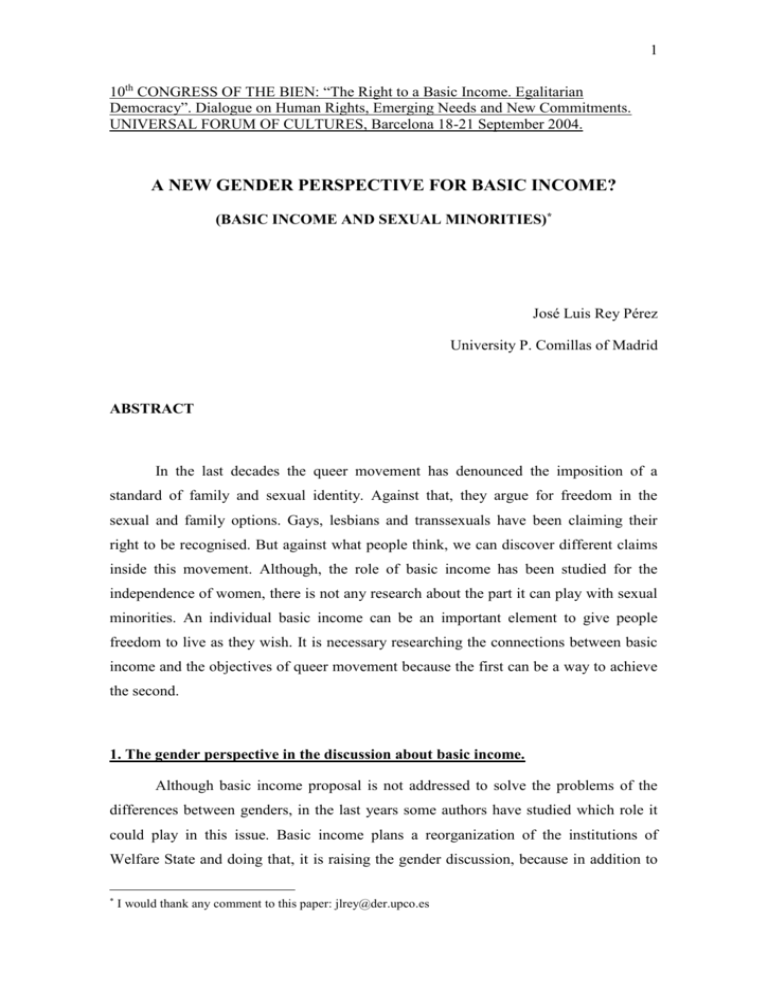
1 10th CONGRESS OF THE BIEN: “The Right to a Basic Income. Egalitarian Democracy”. Dialogue on Human Rights, Emerging Needs and New Commitments. UNIVERSAL FORUM OF CULTURES, Barcelona 18-21 September 2004. A NEW GENDER PERSPECTIVE FOR BASIC INCOME? (BASIC INCOME AND SEXUAL MINORITIES)* José Luis Rey Pérez University P. Comillas of Madrid ABSTRACT In the last decades the queer movement has denounced the imposition of a standard of family and sexual identity. Against that, they argue for freedom in the sexual and family options. Gays, lesbians and transsexuals have been claiming their right to be recognised. But against what people think, we can discover different claims inside this movement. Although, the role of basic income has been studied for the independence of women, there is not any research about the part it can play with sexual minorities. An individual basic income can be an important element to give people freedom to live as they wish. It is necessary researching the connections between basic income and the objectives of queer movement because the first can be a way to achieve the second. 1. The gender perspective in the discussion about basic income. Although basic income proposal is not addressed to solve the problems of the differences between genders, in the last years some authors have studied which role it could play in this issue. Basic income plans a reorganization of the institutions of Welfare State and doing that, it is raising the gender discussion, because in addition to * I would thank any comment to this paper: jlrey@der.upco.es 2 the classical critics to welfare institutions as their ineffectiveness, their slowness, the poverty and unemployment traps, the feminist authors have pointed out the male chauvinism of the Welfare State. The welfare institutions were designed in accordance with a model that does not include everybody, a model where the only family option available was the heterosexual marriage. In this society men had all the power and women were in a secondary place, without the recognition of a full citizenship. In the Welfare State the citizenship was linked to the development of a work valued and paid by the market, that is, citizenship depended on having a job. The labour market was in this sense the way to obtain social inclusion. Women were only the wives of workers. They only had access to pensions or to other social rights if their husbands were entitled to them. As citizenship makes sense in public life, the link between woman/wife and citizenship was not direct (A. McKay and J. Vanevery, 2000, p. 273). For example, the statistics that study the labour market are wedded to male employment patterns (T. Fitzpatrick, 1999, p. 157). In this situation the tasks done by women were not valued but they contributed in the same way as men to the maintenance of that model of society. What men could do out of their houses was possible only because women worked inside. But the political institutions did not recognize that type of work considering that it owned to the private sphere. That false distinction between public and private fields was created to maintain the power of the dominant gender. The care work is heavy too and it has not the salary or recognition as incentives (D. Schoroeder, 2001). Feminist authors denounced all these deficits that the welfare institutions had. Although it is a generalization talking about feminism as a general approach because it is possible to distinguish different versions with different objectives, arguments and methods as liberal, cultural, Marxist or postmodernist feminism, all the feminist authors agree in the male bias of the Welfare State. This bias affects all the paradigm of Modernity built over a concept of universality that is blind to the differences among sexes, ethnic groups and so on. The feminist authors have vindicated in the last decades the difference, the freedom to be and live in a different way to the standard imposed by males. The standard of Modernity has not been able to pass the test of the existence of social groups like women, blacks, ethnic groups that have been excluded, subordinated and oppressed only because they did not coincide with the standard juridical subject, only because of their difference (M. J. Añón and P. Miravet, forthcoming). 3 From the sixties the feminist movement has achieved to modify in some things the situation described above. In western countries where the Welfare State is developed, the insertion of women in the labour market and in the education system is a fact. However, in these countries there are still some discriminations based on gender; usually women are the ones who choose part-time jobs in order to take care of children and family, they have lower salaries in the same jobs and so on. The women have achieved a presence in the public life paying a higher price than men for it. Women use to add to their labour day the care work without any help of their husbands. The aim of basic income proposal is to solve many of the deficits of welfare institutions. It is well known that there are two ways of arguing for basic income; the first one is presenting principled reasons defending basic income as an institution derived from the principles of a theory of justice, the second one consist on presenting pragmatic arguments in favour of basic income compared to the traditional welfare institutions. The pragmatic arguments for basic income have claimed that basic income can be a solution to the poverty and unemployment traps, to the stigmatised aspect of welfare institutions and their ex-post character (D. Nissan and J. Le Grand, 2000, p. 4) and it could mean saving money against the high administrative cost of Welfare State (A. Gray, 1988; D. Purdy, 1988; B. Jordan, 1995; P. Van Parijs, 1996; D. Raventós, 1999; P. de Beer, 2000 among others). In accordance with this argument, basic income would work equipping with unit the institutions of welfare State, because those institutions are fragmented and sometimes contradictory (C. Gamel, 1995). The reform tried by basic income proposal consisting on changing the redistributive institutions has questioned to feminism if it would serve to solve the male bias of the welfare institutions or, on the contrary, if it would contribute to make it larger. It is necessary to point out that basic income is not a political instrument designed to solve all the social problems we have. In fact, it is impossible to imagine an institution able to give answers to all these problems. From my point of view, when we examine a political proposal with the aim to solve a problem different from the gender one, we have to verify if it helps to solve that problem in some size or, by contrary, if it contributes to make it larger. In consequence, a positive evaluation of basic income from the feminism is possible if we can conclude that an institution as basic income doesn’t contribute to increase the gender discriminations or if it can help in some sense to reduce them. It makes no sense saying that we would defend basic income only if it 4 solves the problem of gender discrimination because it is not an institution designated with that purpose and we have to evaluate each institution in accordance with its objectives. But we can demand that the implantation of basic income does not produce greater gender discrimination. And if basic income helps to diminish that discrimination, much better. We would have to reject basic income if although it achieves the redistributive objectives, its consequences suppose a greater gender discrimination, if it contributes to machism of welfare institutions. The consequences of basic income for women have been studied by a group of authors with different conclusions. Some of them argue that it would have positive consequences. They pointed out, firstly, that basic income would increase the autonomy and the economical independence of women. As nowadays women have less economical autonomy than men, a basic income would increase the power of women; that quantity of money would liberate them from male domination because with a basic income the worker status looses its meaning and that would give force to people, as women, that are excluded of that status (H. Parker, 1993, p. 61). In this sense, Pisarello talks about basic income as a gender power that fights against the male power (G. Pisarello, 2001-2002, p. 101). Secondly, basic income recognises the value of activities that are not valued by the market; these works, as the care work, are developed by women and they are important for our societies. Basic income is a recognition of those tasks and it could contribute to a better distribution of work among genders. Thirdly, the basic income is not a familiar institution but individual. Each man or woman perceives the basic income independently from they live single or accompanied. With the family structure of the institutions of Welfare State, many women are obliged to leave their jobs to achieve that their husbands maintain their right to some programs. Being individual, basic income is fixed and it does not depend on the salary the husband or the wife brings to the home. Parker has pointed out that basic income would make better the position of women with part time jobs, especially those ones with lowest salaries and it would help to obtain the equality of salaries between men and women (H. Parker, 1993, pp. 47-60). In this sense, it has been pointed out that women are the main ones who suffer the stigmatisation of the institutions of Welfare State; if basic income helps to reduce the stigmatisation it would improve the position of women (L. Pautassi, 1995, p. 271; T. Fitzpatrick, 1999, p. 166). 5 However, there are other authors who do not agree with these positives consequences of basic income for women. These authors think that the only thing that basic income would obtain would be perpetuate women in housekeeping and care work, without managing to acquire an authentic and true citizenship (I. Robeyns, 2001). As basic income makes possible choosing between a paid and an unpaid job, the male bias of our societies would force a lot of women to choose the second one. In consequence, basic income would contribute to make bigger the problem we want to solve. And if as consequence of basic income more flexible jobs are created and with worse salaries, probably all these works would be chosen by women, so basic income might reinforce the sexual division of labour and labour market segregation (T. Fitzpatrick, 1999, pp. 167-168). I. Robeyns has pointed out that it is impossible to say which type of effects basic income could have over women in general. The consequences depend on different circumstances (I. Robeyns, 2000). Women with low earnings capacities and weak labour market attachment would gain from basic income; they usually are housewives and single mothers. Obviously, basic income would not be the solution to all their problems. Women with high earnings capacities and a strong labour market attachment, that is, women with career, autonomous, without children, with high salaries in short term they wouldn’t obtain anything from a basic income, but Robeyns thinks that in long term they might suffer an increase in discrimination when they try to obtain a job because “when these women are young, it will be difficult for an employer to distinguish whether one of these women belongs to this category, or to the category of the women with high earning capacities but lower labour market attachment” (Robeyns, 2000, p. 132). There would be a third group composed by women with high earnings capacities but a weak labour market attachment; these women would gain from a basic income because they are students, young mothers taking parental leave or women taking care of dependant elderly or ill persons. With a basic income they would be independent economically or at least they could choose more freely a part time job. However, “it is possible that a basic income can be used as a tool to exercise social or individual pressure on these women to withdraw from the labour market” (Robeyns, 2000, p. 132). In last place, there is the group of women with a strong labour market attachment and low earning generating capacities. These women are obliged to work to keep the welfare of themselves and their families. In short term, they would gain from basic income, but in long term they could be cut off the labour market losing the low earning capacities they have. 6 As we can see, it is difficult determine exactly the consequences of basic income for women. If we follow the research made by Robeyns, we verify that the group of women with the worst position nowadays would gain from basic income, and the group of women with the best position would be in the same place with or without basic income. If we could demonstrate that the negative consequences in long term for the women with a good position or for the women with a strong labour market attachment and low earning capacities are not true, basic income would be consistent with what Rawls called the difference principle (Rawls, 1971). Basic income would improve the position of worst located women and it would not make worse the position of other women. If we can obtain a little benefit for the equality between men and women, basic income is an institution that pass the gender test, an institution coherent with the fight against gender discrimination. 2. Another gender perspectives. The fight for recognition of the sexual minorities. The gender approach is problematic. The Welfare State was built over a model of a heterosexual family that nowadays is overcome. In western societies we see another types of families that claim for recognition. In fact, what is known as crisis of Welfare State more than a financial crisis is a legitimacy one. The Welfare State after the II World War developed policies that assumed and generalized behaviours and lifestyles that in some sense violated the neutrality liberal principle. A society where the model of family was heterosexual, white, composed by a male worker and a wife occupied in taking care of children. In the sixties the new social movements presented a group of claims to the State. They demanded the recognition of identities, lifestyles that were excluded, out of the canon. Feminism is a good example. But there were others. Those claims came from oppressed or underrepresented groups that vindicated the recognition of their difference and their equality; they claimed for being equals in their difference. These groups were, for example, ethnic minorities that demanded the recognition of other cultures different from the universalistic model that it is not culturally neutral. And among these groups were the gay, lesbian and transsexual movement that claimed their recognition and their visibility. As they did not enter in the canon, they were condemned to live on the margins of the society. But the claims of this last group minority have evolved in the last decades. The history of the gay, lesbian and transsexual movement is complex and I cannot go further 7 deeper. These claims started before the development of the welfare policies; in Germany started what is know as homophile movement; it vindicated the disappearance of sodomy crimes of the criminal laws and homosexuality as an illness in health books and practices. However, the homophile movement did not question the society and it did not propose an alternative one, it only tried to demonstrate that it was possible being homosexual contributing to create a homosexual identity. Later, in the sixties and mainly after the disturbances of Stonewall, New York on 27th of June of 1969, the gay movement joined to a group of new social movements began to criticize the structures and values of the heterosexual supremacy. It was organized around the analysis of the oppression suffered by gays and lesbians. The homosexuality was presented as an oppressed and ignored identity by the heterosexual structures of power. What they wanted was the right to be recognised as an equal identity, but they went farer than the purpose of homophile movement, because they wanted to change the society. That change couldn’t be done by the heterosexual people who had the power; it had to be done by gays and lesbians. They had to change the standards about gender and identity. In this sense, the homosexual identity was a revolutionary identity (A. Jagose, 1996, p. 37). But these claims found some difficulties. Usually the claims for the recognition are made by some groups with a common culture (I mean here culture in a very broad sense). The ethnic or cultural groups underrepresented claim for an equal recognition and the possibility to life in accordance to their difference. The problem is not in the content of their claims but in the concept of group. Who owns to the group? Which are the criteria to belong to a concrete group? It is in the border of these groups where we find the difficulties of these claims. There are some affirmative actions used by legal systems to obtain the equality of underrepresented group. In the American jurisprudence they talk about “suspect groups”, as those groups that deserve the positive actions. There are three necessary conditions to recognize a group as a suspect one: 1) that group must have been subject over a considerable period of time to intentional discrimination; 2) the group must have been denied the opportunity to redress that discrimination through the usual political process, perhaps because it is numerically a small group; and 3) the group should be identified by some immutable or obvious and fixed characteristic like skin colour (S. Le Vay, 1996, p. 237). In accordance with this concept of suspect group, the problem of the 8 borders of the group attempts to be solved with the last requirement, looking for an objective element that make possible the inclusion or exclusion of that group. And it is in this point where there are a lot of problems with the demands of recognition of some collectives, as homosexuals. Gays, lesbians and transsexuals do not have any problem with the first two requirements. Historically, at least in the last centuries, they have suffered an intentional discrimination in many sides of the social life: in the education system, in employment, in the army, in the law where sodomy was a crime, in marriage, in the possibility to adopt or create a family, in social security and so on (The Editors of the Harvard Law Review, 1990). This discrimination is explained by the intention to maintain a heterosexual supremacy. And here we find the second requirement, because they are not a large numerically group, gays, lesbians and transsexuals have not had the possibility to access to the public political discourse designed in accordance with heterosexual standard. The liberal political institutions have been blind to another lifestyles different from heterosexuality, “in fact, social contract and heterosexuality are two interchangeable notions” (M. Witting, 1989, p. 245). The problem begins with the third requirement because we would need that sexual orientation was fixed and objective. The problem, in other words, is the concept of identity. In this sense, we can divide the authors who have studied the homosexuality in two groups; those ones who support a constructionist approach and those who support an essentialist one. Last ones think that sexuality is determined by biology and in consequence a person’s sexual orientation is a culture independent, objective and an intrinsic property, it is previous to culture (S. Epstein, 1990, p. 242; E. Stein, 1990, p. 325). In the other side, constructionists think that sexuality and sexual identity are social constructions that belong to culture and not to biology; sexual identity is not something objective. Social constructionist work from four premises: 1) All our knowledge is mediated culturally, the way we study the world is determined by the methods, concepts and categories available; 2) the concepts and categories we use vary in their meaning over time and across cultures; 3) the popularity of a concept, category or method depends more on its usefulness than on its validity; and 4) descriptions and explanations of the world are themselves forms of social action (L. Tiefer, 1990, pp. 297-281). In this sense, the difference between essentialists and social constructionists is that “in the first case, there is considered to be some “essence” within homosexuals that makes them 9 homosexual […] In the second case, “homosexual”, “gay” and “lesbian” are just labels created by cultures and applied to the self” (S. Epstein, 1990, p. 242). Usually essentialism is linked to determinism, essentialists would think that sexual identity is determined, it isn’t a matter of choice. But this have been discussed by some authors who defend that it is possible being essentialist and voluntarist, that is, thinking that people can choose to be heterosexual or homosexual. As one woman can choose to be a biological mother (something that is not object of cultural choices), it could be possible to choose being homosexual although homosexuality wouldn’t be a cultural construction and would be objective. In the same sense, it is possible be a constructionist and a determinist if someone think that sexual identity is created by culture that people can not choose, that is, determined by context or other circumstances (E. Stein, 1990). It is necessary to distinguish two discussions that are not linked. The discussion about if the sexual orientation is or is not chosen is different from the discussion about if sexual identity is a product of culture. In the first one we are discussing about if there is some freedom to choose the sexual preferences, the sexual option. In the second one, we are discussing about if sexual identity is determined genetically or built by culture around the sexuality as different from sexual acts. This is not the place to discuss the determinism because there is not a definitive answer to this dilemma. In my opinion, in some circumstances people can choose the sex of people with whom they have sex and in another it can be conditioned by some circumstances as the education or the environment. In any case, and this is a personal opinion, there is always a space of freedom because each person is who decides finally having sex with someone. As E. Stein has pointed out, we have to think that the elections of lesbians and gays, and also of heterosexuals, are made in accordance with their sexual desires, the culture where they live and their experiences, “regardless of whatever sexual orientations are directly chosen, indirectly chosen, or not chosen at all, people choose with whom they have sex, people chose whether to be open about their sexual orientations, people choose whether or not enter into relationships, and whether or not to build families” (E. Stein, 1999, p. 347). However, the debate between essentialists and constructionists is very important when we are discussing the recognition policies because that debate is over the concept of identity, the main concept in the claims for recognition. The way of arguing the rights 10 of gay and lesbians will depend on if we follow one or another theory. In this sense the gay movement hasn’t follow a coherent argument. Some activists have used essentialist arguments because it is easier if we follow this thesis carry out with the third requirement to identify homosexuals as a suspect group. In fact, in the last years in Europe the claims of a lot of gay collectives have followed this way of thinking. For example, in Spain these claims have had a lot of presence in the media in these two last years. Arguing the homosexual identity as a given identity means to establish borders and to open exclusion processes. The fulfilment of identity requirements to belong to a group and being recognised by it is, at the end, another mechanism of power and domination. In this sense, J. Butler points out that “the affirmation of “homosexuality” is itself an extension of a homophobic discourse” (J. Butler, 1991, p. 14). In consequence, arguing a homosexual identity marking out limits and characteristics is drawing a border between those who fulfil the requirements and those who do not, between the ones who are inside and those who are outside. This is being used nowadays by some collectives that, far from the original vindications of the gay movement, have accepted the capitalist model of society, a consumist, liberal, and bourgeois model. These collectives only demand enter in this model. The vindication of homosexual marriage is an example of this. These groups in last years through an alliance with capitalist forces have created a gay identity based on consumism, in the physical beauty, an identity that consist on going out to night clubs and buying expensive clothes. Obviously, the market is interested in this way of seeing the gay identity. That is the reason because the acceptance of homosexuality has come through the market. The equality of rights to access to marriage or the equality in pensions or in adoption means the vindication to move in bourgeois and conservative policy what has already obtained in the market. These collectives do not question the social order, they do not question the oppressive structures of capitalism. They demand be part of the system, becoming oppressors. The market identity of homosexuality has created a lot of exclusions. Out of that identity are the poor homosexuals, the old ones, those who have not liberal jobs, in some sense also lesbians and, of course, people with another practices as sadomasochist ones. All this people don’t feel represented by the market gay identity. With the vindication of this concrete identity all the people who are not inside that group is being 11 excluded; as Cohen points out “while affirming a distinctive group identity that legitimately differs from the larger society, this form of political expression simultaneously imposes a “totalising” sameness within the group. It says, this is who we “really are”” (E. Cohen, 1991, p.75). In this sense, going out of the closet could create new closets, because being out in some sense depends on being inside and it makes sense only if there is that dualism, “being “out” must produce the closet again and again in order to maintain itself as “out”. In this sense, outness can only produce a new opacity” (J. Butler, 1991, p. 16). This conservative side of the homosexual movement has been contested by other groups of homosexuals. Those groups from the last years of the eighties and the first of nineties are called queer movement. Different from the group who vindicate a homosexual identity that wants to be part of the bourgeois society, these thinkers question the concept of identity. It is impossible explaining the queer movement without the AIDS crisis. The AIDS means a change in the way gays, lesbians and transsexuals live their sexuality. Beyond the medical aspects, AIDS is, in accordance to R. MèndesLeite an “epidemic of significance” that affected a lot of our cultural meanings like social compositions, the social and racial borders, the sexual uses, the moral thought and so on (R. Mèndes-Leite, 2000, p. 155). The way of life achieved with the sexual liberation movement that began in the sixties ends with AIDS. The AIDS crisis meant a change in the way people entered into relationships or the way they understood some feelings. All these conquests have had to be reinvented; in the gay scene new practices appeared trying to combine pleasure and safe practices as, for example, the jack-off parties (M. Pollak, 1993). But AIDS affected identity too and helped to question that category. In the first years of the crisis, people talked about “risk groups”, where homosexuals were one of the main groups (in fact, in first years of the epidemic, the AIDS was seen as a gay disease). When people had more information about the virus and the ways it is transmitted, they started to talk about “risk practices” and no “risk groups”. There is not an illness linked to identity, but to some sexual practices; maybe because is the own identity what does not exist, it is a concept used by the power with the aim of oppression. In this sense, what is known as queer movement means a break with the previous gay movements. We can understand this change if we see the historical context where it 12 is produced. The queer movement denounced identity as a cultural fantasy or myth. The queer authors try to deconstruct those concepts and categories like gender or identity that had been assumed without enough reflection. They point out that these concepts are cultural constructions that are not given and in consequence we can play with them. Identity is then a process, something that always is incomplete and under construction, identity is not an innate characteristic but a social construction defined through the social interaction processes. There is not a link between behaviour and homosexual identity. People that do not identify themselves as homosexuals can do homosexual acts. It is not possible to talk about homosexual identity, now we have to talk about plural identities, plural homosexual (or not) identities. With the queer movement we discover some identities hidden like masculine and feminine transsexuals, the rituals of dominance and submission of leather world, the voyeurism or the exhibitionism. All these identities are equal and they are not fixed. Identity is now perceived as an adventure very close to the claim to the freedom to live in the way everyone chooses, without following some costumes, inventing new lifestyles. Gender and identity are perceived as cultural constructions that are possible to modify and play with them to create new identities and new genders. In this sense, “queer theory represents a deliberate move away from the divisiveness of the politics of identity” (S. Cooper, 2000, p. 24). The homosexual concept is seen as a construction of the heterosexual dominance and some queer authors argued for the no distinction between heterosexuality and homosexuality and the freedom to live without following predetermined schemes. In this manner, the political compromise of queer movement is larger than the compromise of the homosexual activists who want to be accepted by the bourgeois society without questioning its institutions. The queer authors want to modify the structures of power of the society and with that intention they put freedom in first place and as the central concept. Doing that, they give relevance to the excluded inside the homosexual movement, those ones who haven’t been accepted by the market homosexuality. The queer activists claim that freedom is the main right of people and they point out the contradictions of the liberal model that defends freedom only if it is used to choose some concrete options. These contradictions pointed out by the feminism are examined now from another perspective, the queer movement that is not the largest one inside the homosexual collective and that is attacked by the mercantilist gay sides of the collective. 13 3. Basic income, a redistributive or a recognition policy? When we face to social justice claims we can distinguish two types. The first one, maybe the one that is more classic and extended, is the redistributive one consisting on demanding the distribution of scarce resources among people. The welfare State and its institutions is a redistributive policy. The discussions maintained from the apparition of Rawls´ Theory of Justice (Rawls, 1971) belong to this field. But some authors saw that it was not enough with distributive policies to achieve social justice. The excluded or underrepresented groups began to talk about recognition policies, which objective is the recognition of their difference. The two policies are linked to different social movements. The politics of redistribution are usually related to class policies, with the intention of make equal the class differences, while the politics of recognition is assimilated to identity policies, with the purpose of recognise identities underrepresented due to the existence of a dominant culture. In this sense, the redistributive paradigm studies the socio-economic injustice rooted in the economic structure of society and the recognition paradigm analyses the cultural injustices rooted in the mechanism of representation, communication and interpretation (N. Fraser, 2003). If we follow the redistributive model the remedy to injustice consist on making a different distribution of scarce resources. In accordance to the recognition model the solution to injustice is a cultural change, valuating the difference, the diverse identities and the cultural disparity. Though, as recently N. Fraser has pointed out, this distinction is artificial. It can be useful to make some analytical or conceptual analysis, but actually the injustices are not only distributive or recognition ones. The injustices suffered by many people have two sides, one economically and another related to recognition. Distribution and recognition are two sides from we can think about social injustice and probably we would have to take account another sides, because this is a discussion about perspectives. We can analyse a concrete social injustice from one or another perspective. The discrimination suffered by homosexuals can be studied from this double perspective. Lesbians, gays and transsexuals have suffered economic discrimination in the access to some jobs, in the taxes, in pensions and so on. But as N. Fraser has pointed out, this discrimination is explained by laws that try to impose the heterosexual 14 paradigm more than by some class inequality, that is, the negative economic effects are consequences of a cultural subordination: “the ultimate cause of heterosexist injustice is the status order, not the economic structure of capitalist society. But the resulting harms include misdistribution as well as misrecognition; and economic harms that originated as by-products of the status order have an undeniable weight of their own” (N. Fraser, 2003, p.24). In justice, both sides, distribution and misrecognition are related. The misrecognition of a group automatically has economical consequences. It could be different, but generally this happens. That is the reason why N. Fraser argues for a concept of justice that includes both sides, the redistributive and the recognition ones. She doesn’t think that they are alternatives or antithetic visions of social justice. They are sides of the same injustice. And in each circumstance we have to examine which type of economic and cultural injustices are present and how to solve them. Anyway, the distinction between economical and recognition or cultural aspects of social justice is useful to evaluate the different policies that try to make real social justice. Obviously, there are policies with a deep redistributive bias: for example, the minimum insertion income, the financial support to education for families without resources or an universal health care system have, at first sight, an obvious redistributive purpose. In the other side, there are policies with the purpose of recognising some groups, like the affirmative institutions that go after the equality between men and women. In these examples, the policies have consequences in the other dimension of social justice. In one side, the insertion income can help to end the social exclusion of some collectives misrecognised culturally as, for example, prostitutes or ethnic minorities that haven’t resources to survive because of a xenophobic discrimination; with the quantity of the insertion income and an insertion program they can walk the first steps to achieve the recognition as full members of society. The financial support to education for families with scarce resources have consequences in the recognition policies, because it could help ethnic excluded minorities to have access to superior education, as in Spain could happen with the gipsy collective. The universal healthcare system could help to the recognition of some groups; if, for example, it includes the surgery to change the sex, it would help to the recognition of transsexual collective. In the other side, an affirmative discrimination that allows a misrecognised group the access to important positions could contribute to 15 improve its economic position. In consequence, any redistributive policy has consequences in the recognition policies and vice versa. In addition, this gives us a criterion when we try to evaluate the pertinence of a concrete social policy. As I pointed out earlier, when we examine a concrete social policy we have to study not only the consequences in the field it directly try to act but also in the other side of social justice. If we are examining a distributive policy we have to analyse the consequences it has in the recognition objectives. When I talked about basic income from a gender perspective, I said that basic income was a good policy only if it helps to improve the position to women or if it hasn’t negative consequences to them. If it has negative consequences to gender equality then basic income is not a good policy to achieve social justice, although it had very good redistributive effects. This analysis is required by the recognition policies too. These types of policies are coherent with social justice only if it does not help to make larger the economical inequality (or at least it has no consequences in the resources distribution). Basic income is a redistributive policy. Its purpose is achieving a fair distribution of resources in society and all the arguments given have gone in this address. P. Van Parijs in Real freedom for all, defends that basic income is the best way to distribute external assets, including among them not only external ones but also jobs in a context of not enough available jobs (Van Parijs, 1995). The purpose of basic income is mainly distributive. But it is necessary to evaluate its consequences in the field of recognition. Some feminist authors have made this as we saw before. But it is possible to evaluate basic income from the consequences it could have for another misrecognised groups. One of them is that composed by sexual minorities. 4. Basic income and the claims of sexual minorities. At the time of examining this question it is necessary to see which are the vindications we are going to consider because we have already seen that inside the collective of gays, lesbians and transsexuals not everybody is claiming the same rights. Although it can be a generalization, in my opinion, inside that movement it is possible to distinguish two large groups. Those ones who don’t discuss the established social order would compose the first one; they only demand correct inequitable outcomes of that social order without disturbing the underlying structures that generate them. This 16 strategy is known as affirmative one (N. Fraser, 2003, p. 74). In the homosexual movement, this strategy corresponds with the one of which assuming the existence of identity concept and, in concrete, the existence of a gay identity, demands to the institutions of society the recognition of their different identity. These claims consist on the vindication of homosexual marriage, adoption, social security benefits and so on, that is, the comparison of homosexual relationships to heterosexual ones; but they don’t discuss the models of relations accepted in our societies, they only want to open that model to include homosexual relations. What is claimed here is the extension to the political field what it has already been accepted by the market. The second one would be composed by those who discuss the present structures and claim for an alternative one. Their strategy would be transformative because they want to correct unfair outcomes by restructuring the underlying generative framework. The queer movement which purpose is deconstructing the categories of gender and identity and the binary homosexuality-heterosexuality is inside this second group. This last strategy means a radical change of society and this is the reason they repel the demands of the other groups. They think that claiming institutions like marriage means perpetuating the present structures of power and excluding those who do not enter in the canon. The transformative strategies of queer movement try a social design open to any option and to any identity, where freedom acquires a deep sense. These two visions of the vindications of the sexual minorities are opposed in many aspects and we cannot joint them in the same group. Now I want to examine if basic income can play some role in these two strategies. If basic income contributes to the demand of recognition presented by these two groups or, at least, it doesn’t harm it, basic income will be a good redistributive policy when we examine it from the perspective of recognition. If basic income harms the recognition of these collectives, then it does not pass the exam that all redistribution policy must pass if it want to be consistent with social justice. In my opinion, the role that basic income can play in the demands of homosexuals is reduced. Giving everybody an unconditional income gives a margin of freedom that could help many boys and girls to go out of the closets or to live their life in accordance to their preferences. But unfortunately, the vindications of a part of the homosexual collective are the political extension of a dominant position they enjoy in the market. In this sense, being basic income a redistributive policy, its objectives are 17 not improving the dominant class but the contrary, although in this case the dominant class do not enjoy enough recognition. From my point of view, a lot of homosexuals would not support an institution as basic income because it would private them of their economic dominance and it would mean a risk to the narrow homosexual identity they try to impose. Where basic income could play an important role is in helping to achieve the claims of queer movement. The objective of basic income is real freedom, that is, “being free consist in not being prevented from doing not just what one wants to do, but whatever one might want to do” (Van Parijs, 1995, p. 19). Real freedom is what makes a society fair. What the queer movement is demanding is this concept of real freedom. Pointing out the exclusions created by the category of sexual identity, they vindicate that everyone live in accordance to their preferences, without following any predetermined scheme. And here basic income can be a way to achieve this objective. With an income guaranteed unconditionally, people have means to dare to live freely. A policy as basic income which purpose is to fight against the domination suffered by people forced to work in nowadays societies serves at the same time to finish with the heterosexual dominance. Basic income gives people resources to choose their lifestyles without fear to possible reprisals for their options. Fighting against economical dominance we achieve the cultural liberation. Those are the reasons why I think a majority of queer activists would defend a basic income. Because both, the ones who support basic income and the queer activists are talking about the same from two different perspectives: about freedom. The freedom to live as everyone might want to do without any cultural or economical oppression. Having a basic income make easier live the own sexuality and could make possible to think about identity as an individual plan and not as adhesion to a lifestyle given. The positive consequences of basic income for marginal sexual collectives justify, from the recognition side, this distributive policy. Basic income can be an instrument to make real the aspirations of freedom claimed by the queer movement. Amsterdam-Madrid, July 2004. 18 REFERENCES: AÑÓN, M. J. and MIRAVET, P. (forthcoming): “El derecho a un ingreso y la cuestión social de las mujeres europeas” in G. PISARELLO (ed.), Razones para una renta básica de ciudadanía, Trotta, Madrid. BEER, P. DE (2000): “In Search of the Double-Edged Sword” in R. VAN DER VEEN and L. GROOT (eds.), Basic Income on the Agenda. Policy Objectives and Political Chances, Amsterdam University Press, Amsterdam, pp. 41-52. BUTLER, J. (1991): “Imitation and Gender Insubordination” in D. FUSS (ed.), Inside/Out. Lesbian theories, gay theories, Routledge, London, pp. 13-31. COHEN, E. (1991): “Who Are “We”? Gay “Identity” as Political (E)motion (A Theoretical Rumation)” in D. FUSS (ed.), Inside/Out. Lesbian theories, gay theories, Routledge, London, pp. 71-92. COOPER, S. (2000): Relating to Queer Theory. Rereading Sexual Self-Definition with Irigaray, Kristeva, Witting and Cixous, Peter Lang, Bern. EPSTEIN, S. (1990): “Gay Politics, Ethnic Identity: The Limits of Social Constructionism” in E. STEIN (ed.), Forms of Desire. Sexual Orientation and the Social Constructionist Controversy, Garland Publishing, New York, pp. 239-293. FITZPATRICK, T. (1999): Freedom and Security. An Introduction to the Basic Income Debate, MacMillan Press, London. FRASER, N. (2003): “Social Justice in the Age of Identity Politics: Redistribution, Recognition, and Participation” in N. FRASER and A. HONNETH, Redistribution or Recognition? A Political-Philosophical Exchange, Verso, London, pp. 7-109. GAMEL, C. (1995): “Compétitivité Internationale et Chômage en Europe: vers la réforme de l´allocation universelle ?”, Groupe de Recherche Sur L´adaptation, la systémique et la complexité économique, Université d´Aix-Marseille III, January. GRAY, A. (1988): “Resisting Economic Conscription”, Capital and Class, no. 34, pp. 119-146. JAGOSE, A. (1996): Queer Theory. An Introduction, New York University Press, New York. JORDAN, B. (1995): “Are New Rights Policies Sustainable? `Back to Basics´and Public Choice, Journal of Social Policy, vol. 4, no. 3, pp. 363-384. LE VAY, S. (1996): Queer Science: The Use and Abuse of Research into Homosexuality, Massachusetts Institute of Technology, Cambridge. MCKAY, A. and VANEVERY, J. (2000): “Gender, Family and Income Maintenance: A Feminist Case for Citizens Basic Income”, Social Politics, Summer, pp. 266-284. 19 MENDES-LEITE, R. (2000) : Le Sens de L´Altérité. Penser les (homo)sexualités, L´Harmattan, Paris. NISSAN, D. and LE GRAND, J. (2000) : A Capital Idea. Star-Up Grants for Young People, Fabian Society, London. PARKER, H. (1993): Citizen´s Income and Women, BIRG Discussion Paper no. 2, Basic Income Research Group, London. PAUTASSI, L. (1995): “¿Primero… las damas? La situación de la mujer frente a la propuesta del ingreso ciudadano” in R. LO VUOLO (ed.), Contra la exclusión. La propuesta del ingreso ciudadano, Miño y Dávila, Buenos Aires. PISARELLO, G. (2001-2002): “La renta básica como derecho y como contrapoder”, El vuelo de Ícaro, no. 2-3, pp. 91-108. POLLAK, M. (1993): “Homosexual Rituals and Safe Sex” in R. MENDÈS-LEITE and P-O. DE BUSSCHER (eds.), Gays Studies from the French Culture. Voices from France, Belgium, Brazil, Canada and The Netherlands, The Haworth Press, New York, pp. 307317. PURDY, D. (1988): “Towards a Basic Income Democracy”, Basic Income Research Group Bulletin, no. 8, pp. 10-12. SCHROEDER, D. (2001): “Wickedness, Idleness and Basic Income”, Res Publica, no. 7, pp. 1-12. RAVENTÓS, D. (1999): El derecho a la existencia. La propuesta del subsidio universal garantizado, Ariel, Barcelona. RAWLS, J. (1971): A Theory of Justice, Oxford University Press, Oxford. ROBEYNS, I. (2000): “Hush Money or Emancipation Fee?” in R. VAN DER VEEN and L. GROOT (eds.), Basic Income on the Agenda. Policy Objectives and Political Chances, Amsterdam University Press, Amsterdam, pp. 121-136. -(2001): “An income of one´s own: a radical vision of welfare policies in Europe and beyond”, Gender and Development, vol. 9, no. 1, pp. 82-89. STEIN, E. (1990): “Conclusion: The Essentials of Constructionism and the Construction of Essentialism” in E. STEIN (ed.), Forms of Desire. Sexual Orientation and the Social Constructionist Controversy, Garland Publishing, New York, pp. 325-353. -(1999): The Mismeasure of Desire. The Science, Theory and Ethics of Sexual Orientation, Oxford University Press, Oxford. TIEFER, L. (1990): “Social Constructionism and the Study of Human Sexuality” in E. STEIN (ed.), Forms of Desire. Sexual Orientation and the Social Constructionist Controversy, Garland Publishing, New York, pp. 295-324. 20 VAN PARIJS, P. (1995) : Real Freedom for All: What (if Anything) Can Justify Capitalism, Clarendon Press, Oxford. - (1996): “De la trappe au socle: l´allocation universelle contre le chômage”, Swiss Political Science Review 2 (1), pp. 103-117. WITTIG, M. (1989): “On the Social Contract” in D. ALTMANN, C. VANCE, M. VICINUS, J. WEEKS et. al., Homosexuality, Which Homosexuality?, GMP Publishers, London, pp. 239-249.
